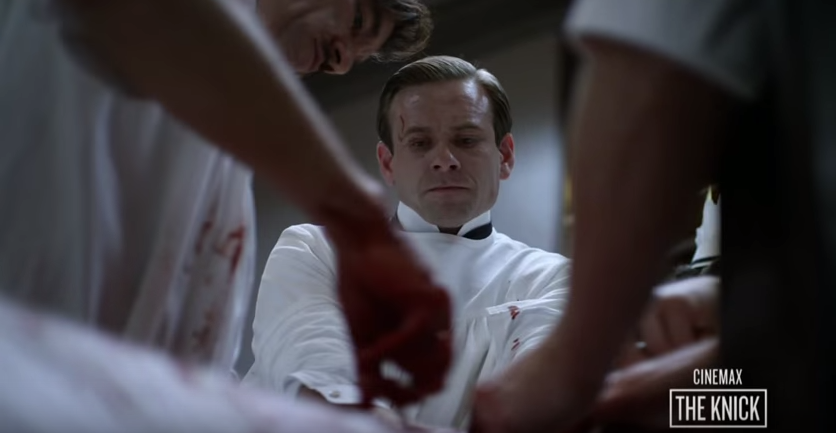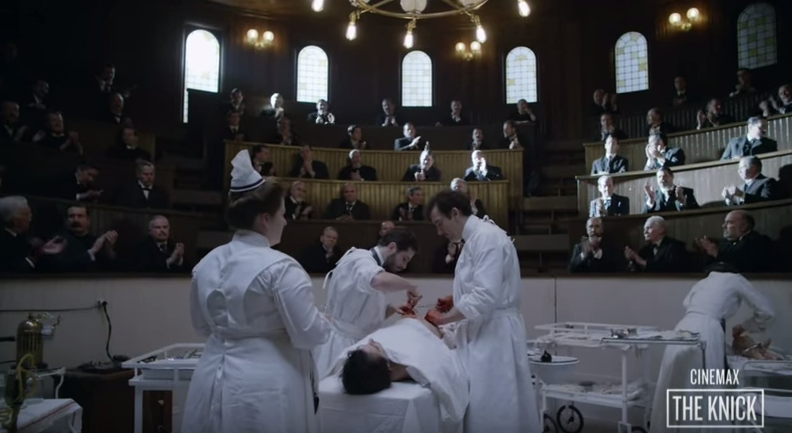
At the turn of the twentieth century, advances in medicine happened at a pace people today might associate with technology.
Setting a medical drama period piece in this era is no small task, but it’s exactly what Cinemax’s “The Knick” does carefully and thoroughly as it explores an important era of medicine through the lens of a New York City hospital.
Set in downtown Manhattan, the hospital, called “The Knickerbocker,” is the stage where director Steven Soderbergh’s portrayal of New York’s social landscape in 1900 unfolds. Along with the sometimes blatantly honest depiction of society’s attitudes toward race, class, gender and medicine as a practice, the show realistically visualizes the medical developments of the time. The C-section, appendectomy and X-ray technology were all unveiled in their early stages during season one.
The show’s main character, Dr. John Thackery (played by Clive Owen), is based on a real-life counterpart from that time. The real-life version of Thackery was a doctor named William Halsted, an important figure credited with several medical advancements, such as the first emergency blood transfusion, the radical mastectomy, the invention of surgical gloves and a revolution in thinking in terms of how surgery is taught to medical students.
Halsted, like his fictional counterpart Thackery, struggled with cocaine and morphine addictions throughout much of his life after experimenting with the drugs as anesthetics.
The video below has depictions of surgery and may be graphic for some viewers. Viewer discretion is advised.
Where Does The Knick Go Wrong?
The show’s depiction of the time in which Halsted worked is not entirely accurate, blending in several story lines from surrounding time periods for the sake of storytelling over historical and chronological correctness. The example of The Knick’s administrative staff tracking down “Typhoid Mary” Mallon as part of the show’s journey to document the early days of public health is not entirely accurate, nor is the presence of African American surgeon Algernon Edwards.
The budding young surgeon is played by Andre Holland and is widely thought to be a screen version of Daniel Hale Williams, an African American cardiac surgeon who founded the first hospital with integrated staff in Chicago around 1891. In the show, progressive minded white hospital administrators push for Edwards’ inclusion, but in reality, it was Williams who pushed to integrate hospitals.
In addition to the anachronisms and occasional fact smudging, if you consider some of the subtle inaccuracies, such as characters not wearing gloves during surgery as they would have around 1900, with Halsted having already invented them, you begin to see where the show’s critics in the history community may have some gripes.
“Conflating medical and surgical history in the 1870s, 1880s, 1890s and 1900s is the medical-historical equivalent to conflating the Middle Ages to colonial America to the Civil War,” Dr. Howard Markel, a physician and medical historian at the University of Michigan told the Wall Street Journal.
Markel’s biggest issue with the show? It may be the only history lesson concerning a watershed era in medical history that many of its viewers ever get.
While that is true and a valid concern, it would be a stretch to say the show recklessly hops around and violates the truth of the times.
You Might Also Enjoy: Call the Midwife: Accuracy, Details and Where Is It Headed?
What Does The Knick Get Right?
The series’ writers, Jack Amiel and Michael Begler, spent hours digging through medical journals of the time to look for storylines and intricate details that would inspire them. The writing duo also consults Dr. Stanley Burns, founder of a medical photographic archive named after him in New York City, as their medical advisor to ensure that the tools and procedures performed by the actors are realistic to the time.
Outside of the operating room, the show depicts the cramped living environments many New Yorkers endured in the early 1900s. This is something that became the center point of early public health legislation thanks to its role in the spread of tuberculosis.
In 1901, the Tenement House Act required improvements to the living conditions of impoverished renters that included better ventilation and running water to be provided to tenants. Through the work of The Knick’s Cornelia Robertson (played by Juliet Rylance) and a public health inspector, the show tackles the beginnings of a profession now charged with managing outbreaks of diseases like Ebola and conducting work we now associate with the Centers for Disease Control and Prevention.
As for hospitals at the turn of the 20th century, The Knick does a fairly good job of portraying the penny-pinching administrators, surgical auditoriums and overall chaotic atmosphere surrounding hospitals of that time.
In fact, The Knick was a real hospital, albeit one based in Harlem rather than downtown Manhattan. The hospital did also treat primarily poor and immigrant patients, a theme the show sticks with and uses to portray class issues of the time.
For fans of historical fiction, the real events that often inspire The Knick’s script and make it move at its fast pace are enticing bits of television. In season one, the writers dedicated an entire episode to an actual race riot that occurred following the death of a police officer during an altercation with an African American man. It is a chaotic episode in which the race relations of the day are on full display.
For fans of unflinchingly embracing reality, The Knick offers enough realistic effects and gore of early 1900s surgery to put the viewer in the operating room. The surgeries and procedures in the show are meant to evoke feelings of horror at times, forcing one to come face-to-face with the medical reality of that time.
“We felt that at minimum, there’s just got to be one thing in each episode that really makes your head snap back,” Soderbergh told the New York Times in August of 2014. “I think we managed that.”
Take a Look at Season 2
What will season 2 of The Knick pack? No one knows really, but there is no shortage of material to pull from the career of Halsted and the best medical minds of his time. There are several medical breakthroughs from which to choose from, including the use of emergency medicine such as epinephrine and using aspirin to thin patient’s blood, to operations on the arteries of Thackery’s patients. Given Halsted’s emphasis on sterility, it wouldn’t be surprising if season two or beyond focuses on the introduction of mattress sutures and hemostats capable of controlling bleeding.
Innovations are likely to come from Edwards as well. When looking at the career of Louis T. Wright, a pioneering African American surgeon of the time, the show can begin to examine the development of cancer drugs, antibiotics and vaccines.
Amid all of it, viewers should expect plenty of experimentation, as this era of medicine was fraught with tests using everything from peg legs to intentional malaria infections. Under Soderbergh’s direction, no brutal detail will likely be spared as it promises to provide the viewer a bleak view of the medical knowledge of that time. The show is a reminder of how modern medicine came about and the fact that 100 years from now, people will likely view the procedures doctors use today as being just as laughably savage as what we see on The Knick.
The first season of The Knick is now available via HBO’s streaming services. Season two debuts Oct. 16 on Cinemax. If you’re a fan of medical television shows and are willing to embrace the sometimes brutally realistic storytelling and Soderbergh’s Gothic style of filming the show, The Knick promises to be a weekly ritual for you.
Do you watch The Knick? If so, we want to hear about your thoughts on the show in the comments section below!









